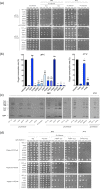Bi-allelic KARS1 pathogenic variants affecting functions of cytosolic and mitochondrial isoforms are associated with a progressive and multisystem disease
- PMID: 33942428
- PMCID: PMC8251883
- DOI: 10.1002/humu.24210
Bi-allelic KARS1 pathogenic variants affecting functions of cytosolic and mitochondrial isoforms are associated with a progressive and multisystem disease
Abstract
KARS1 encodes a lysyl-transfer RNA synthetase (LysRS) that links lysine to its cognate transfer RNA. Two different KARS1 isoforms exert functional effects in cytosol and mitochondria. Bi-allelic pathogenic variants in KARS1 have been associated to sensorineural hearing and visual loss, neuropathy, seizures, and leukodystrophy. We report the clinical, biochemical, and neuroradiological features of nine individuals with KARS1-related disorder carrying 12 different variants with nine of them being novel. The consequences of these variants on the cytosol and/or mitochondrial LysRS were functionally validated in yeast mutants. Most cases presented with severe neurological features including congenital and progressive microcephaly, seizures, developmental delay/intellectual disability, and cerebral atrophy. Oculo-motor dysfunction and immuno-hematological problems were present in six and three cases, respectively. A yeast growth defect of variable severity was detected for most variants on both cytosolic and mitochondrial isoforms. The detrimental effects of two variants on yeast growth were partially rescued by lysine supplementation. Congenital progressive microcephaly, oculo-motor dysfunction, and immuno-hematological problems are emerging phenotypes in KARS1-related disorder. The data in yeast emphasize the role of both mitochondrial and cytosolic isoforms in the pathogenesis of KARS1-related disorder and supports the therapeutic potential of lysine supplementation at least in a subset of patients.
Keywords: KARS; KARS1; LysRS; lysyl-transfer RNA synthetase; mitochondrial disease.
© 2021 The Authors. Human Mutation Published by Wiley Periodicals LLC.
Conflict of interest statement
All the authors declare that there are no conflicts of interests.
Figures





References
-
- Ardissone, A. , Tonduti, D. , Legati, A. , Lamantea, E. , Barone, R. , Dorboz, I. , Boespflug‐Tanguy, O. , Nebbia, G. , Maggioni, M. , Garavaglia, B. , Moroni, I. , Farina, L. , Pichiecchio, A. , Orcesi, S. , Chiapparini, L. , & Ghezzi, D. (2018). KARS‐related diseases: Progressive leukoencephalopathy with brainstem and spinal cord calcifications as new phenotype and a review of literature. Orphanet Journal of Rare Diseases, 13, 45. - PMC - PubMed
-
- Baruffini, E. , Ferrero, I. , & Foury, F. (2010). In vivo analysis of mtDNA replication defects in yeast. Methods, 51, 426–436. - PubMed
-
- Boonsawat, P. , Joset, P. , Steindl, K. , Oneda, B. , Gogoll, L. , Azzarello‐Burri, S. , Sheth, F. , Datar, C. , Verma, I. C. , Puri, R. D. , Zollino, M. , Bachmann‐Gagescu, R. , Niedrist, D. , Papik, M. , Figueiro‐Silva, J. , Masood, R. , Zweier, M. , Kraemer, D. , Lincoln, S. , … Rauch, A. (2019). Elucidation of the phenotypic spectrum and genetic landscape in primary and secondary microcephaly. Genetics in Medicine, 21, 2043–2058. - PMC - PubMed
-
- Carmi‐Levy, I. , Motzik, A. , Ofir‐Birin, Y. , Yagil, Z. , Yang, C. M. , Kemeny, D. M. , Han, J. M. , Kim, S. , Kay, G. , Nechushtan, H. , Suzuki, R. , Rivera, J. , & Razin, E. (2011). Importin beta plays an essential role in the regulation of the LysRS‐Ap(4)A pathway in immunologically activated mast cells. Molecular and Cellular Biology, 31, 2111–2121. - PMC - PubMed
Publication types
MeSH terms
Substances
Grants and funding
LinkOut - more resources
Full Text Sources
Other Literature Sources
Miscellaneous

